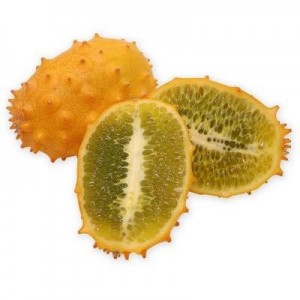
Description
This horned cucumber plant is a annual vine, 1.5 to 3m long of African origin. The stem is angular, ridged and hairy; internodes are 5-8cm long. At each node, a 2.5 to 5cm long curling tendril forms, along with two to four pale yellow male flowers, a leaf petiole, and occasionally a fruiting branch. The small, deeply cut, five-lobed leaves are similar to those of the watermelon. The fruits have an oblong shape, are 5 to 10cm long, light-green until maturity and have distinctive, long, sharp spines on their exterior.
In Zimbabwe, this cucumber is called 'gaka' or 'gakachika' and it is primarily used as a fruit-snack or salad. It is eaten young, mature green or when ripe - bright yellow/orange (i.e eaten at any stage of its development) and it grows naturally in the fields and also in the bush.
Cucumis metuliferus is a member of the Cucurbitaceae (gourd) family.
Seeds/Packet: (min. 10 Seeds)
Please see the Cucumbers category page for detailed Growing Instructions or download the PDF guide from this page.
Extra Info
The plant is sensitive to cold and may be only grown during the warm seasons. Hot, dry conditions are best for preventing powdery mildew.
The plants are grown similarly to cucumbers. Caution is in order because the plants have a "weedy" nature, they are vigorous climbers and robust plants which can quickly take over land. The fruit forms in clusters with the fruit closest to the plant center maturing first. They have to be cut from the vine, gloves should be worn, and care taken not to puncture a neighboring fruit with the spines. The fruit turns bright orange when it is ripe.
No need to refrigerate, the fruits last for several weeks after their initial picking. Do not stack the fruit as the spines can puncture other fruit. In New Zealand the spines are made blunt by sanding. Once they “give” to the touch, they are ripe and ready to eat. Do not store them near apples or bananas, as these fruits will shorten their shelf life.
The fruit of this plant is edible but it is more often used as decoration. Flavour ranges from strong cucumber laced with lemon to bland citrus with hints of cucumber, banana, melon and lime - some say a little too bitter while others recommend eating with a little brown sugar or honey. The fruit pulp can also be strained to make a juice. The ripe interior has a lime green jelly-like flesh with large seeds. They are low in calories (with only 24 calories in 100g), high in vitamin C and fibre and contain more potassium than a banana.
This fruit's versatility extends beyond simply eating it. Cut in half and scoop out the translucent jelly-like flesh to create a unique, striking serving cup. African Horned Cucumber shells can be used as unique serving bowls for soups, sorbets and desserts.























